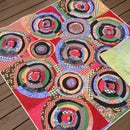Introduction: Christmas Card Sewing
For one or two thousand reasons, sewing on paper does not come immediately to people's minds when they think of lugging out the sewing machine, or strangely enough, even when they think of making Christmas cards. What can I say - it's one of life's great mysteries - BUT this Instructable is going to change all that. From now on you will think paper.... sewing.... Christmas cards... sewing... you are getting very sleepy... your eyelids feel very heavy... when I snap my (virtual) fingers you will awake and think 'I want to sew a Christmas card'. *snap!*
Step 1: What You Will Need
1. Blank cards and envelopes (I used 7" x 5 1/4" cards with an indented panel on the front that acts like a frame)
2. A sewing machine
3. Scraps of fabric
4. Really sharp scissors (because really sharp scissors are one of life's great pleasures and besides that you deserve them.
5. Colorful thread
6. Stabilizer paper or tissue paper to place underneath your fabric while sewing
7. An iron
2. A sewing machine
3. Scraps of fabric
4. Really sharp scissors (because really sharp scissors are one of life's great pleasures and besides that you deserve them.
5. Colorful thread
6. Stabilizer paper or tissue paper to place underneath your fabric while sewing
7. An iron
Step 2: Getting Started
Decide how big you want your fabric design to be and cut or rip fabric accordingly. I find the ripped edge to be an added design element. It's also why I don't bother cutting the ends of threads much, the frayed and thread-y look is what I am going for but be as tight or loose about this as you want.
I like the production aspect to sewing the cards, so I ripped 30 backgrounds, cut out 15 trees (the negative of the cut out tree is used also) and had them all stacked up with the stabilizer paper ready to sew.
I like the production aspect to sewing the cards, so I ripped 30 backgrounds, cut out 15 trees (the negative of the cut out tree is used also) and had them all stacked up with the stabilizer paper ready to sew.
Step 3: Sewing
It is really important to put some stabilizer paper (found at fabric stores) underneath the fabric (tissue paper works great too) before you sew or else the fabric gets all bunched up. I drop the feed dogs on the machine and use a darning foot to be able to "free motion" sew.
Afterwards tear off the paper that sticks out from the edges but it is not important to spend the time to tear away the rest as it won't show and adds no bulk.
Afterwards tear off the paper that sticks out from the edges but it is not important to spend the time to tear away the rest as it won't show and adds no bulk.
Step 4: More Sewing
The thread is doing more than holding the fabrics together, it's part of the design so use lots of it.
Step 5: Sew Directly Onto the Card After Ironing Flat
Everything looks better after it has been ironed and this is no exception, free motion sewing on something so thin tends to get a bit bunched up and messy looking, press flat with an iron and everything straightens out and looks great. Don't skip this step.
It is fun to sew onto paper, it just has a positive feel, again there are no need for pins, just center and sew. As for sewing the greeting I was able to sew Merry Christmas on my first try but after 30 cards I got faster and better, if in doubt practice on some card stock until you are comfortable. I sewed the greeting before I sewed on the fabric design in case I made a mistake it was no big deal to throw out a card. It would have been another story to have to throw out a card with the fabric on it.
It is fun to sew onto paper, it just has a positive feel, again there are no need for pins, just center and sew. As for sewing the greeting I was able to sew Merry Christmas on my first try but after 30 cards I got faster and better, if in doubt practice on some card stock until you are comfortable. I sewed the greeting before I sewed on the fabric design in case I made a mistake it was no big deal to throw out a card. It would have been another story to have to throw out a card with the fabric on it.
Step 6: Finished Cards
Step 7: You Are Getting Very Sleepy....
You will vote for this Instructable..... for the contest..... you will make Christmas Cards on your sewing machine... you will remember to floss...






